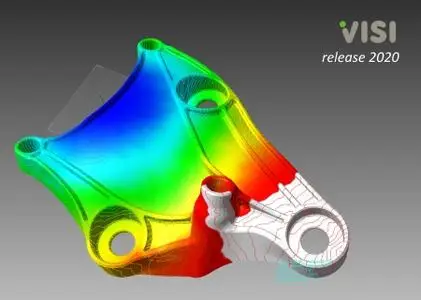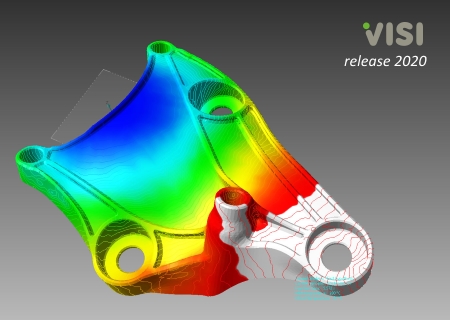Vero VISI 2020.0 | 3.5 Gb
Hexagon’s Manufacturing Intelligence division is pleased to announce the release of VISI 2020.0. The latest release of VISI CAD/CAM, from Hexagon Manufacturing Intelligence’s Production Software business, improves the mould and progressive die design processes, along with enhancement to the Reverse module, specifically designed for the mould and die market.
Vero VISI 2020.0 press release - GLOUCESTER, UK, May 21, 2019:
New part unfolding technology has been introduced in VISI 2020.0, giving the ability to work directly on the original solid part without needing to extract the model’s skin. The sheet metal part recognition now provides an improved graphical representation of the part analysed, by identifying bends, planar faces and features.
The advantage of the new technology is its associativity with the original model during the die design process, as it allows the original part to be edited, and changes to be made automatically on the study of the part. It also means the blank calculation will completely unfold all the detected features and coining faces. The step-by-step process unfolds just the features across the selected bend by automatically rebuilding the relative solid model, and the coining faces will be rebuilt on each step.
Enhancements to the Reverse module provide new functionalities for both Reverse and Casting processes, giving greater flexibility for both processes. Features such as clipping plane management for point scanning, planar face and draft analysis on mesh data, adapting a mesh to a boundary, and best fit, improve the reverse process from point scanning to solid model generation, and manufacturing.
A new Compare feature lets the user compare two entities, such as a point cloud, mesh, or solid, by checking the relative distance – the graphical results show different colours in reference to the distance ranges. The system also shows the relative distance between the two selected entities during the comparison, by simply selecting a point. “The Best Fit and Compare functions are essential for both the Reverse, Casting and manufacturing processes.
Additional Meusburger Mould Tool templates (FB, FM and FW types) are now incorporated, including new plates as well as standard components. The new mould templates also include assemblies from the same supplier. “The benefits of this are that the mould designer will be able to call on Meusburger’s latest mould assemblies.
VISI’s Flow Analysis has been improved by new mesh group technology specifically designed for FEM analysis. It gives a high quality mesh, while reducing computation time, by providing new options to adapt and fit the mesh accordingly to the model’s shape. “It’s possible to control the mesh orientation, the curvature of the model, and smooth the mesh on the transition area, leading to a higher quality, accurate Flow Analysis process.
The flow lines in VISI 2020.0 can now be shown, highlighting possible ‘hesitations’ of the filling from isochrones. This is especially important, as hesitation occurs when the melt flow slows down or stops along a particular flow path, leading to possible asymmetrical and unpredictable flow patterns which can reduce part quality, caused by variations in surface appearance, poor packing, high stresses, and non-uniform orientation of the plastic molecules. If the flow front freezes completely, part of the cavity may remain unfilled, resulting in a short tool.
But now, the engineer can graphically identify possible quality issues caused by flow hesitations, and then simulate alternative solutions. With thermal analysis becoming increasingly more important in optimising mould cooling, the Flow Thermal function has been enhanced by improved coolant flow rate suggestions, giving an indicative value for a single cooling circuit, and an improved solid mesh definition for the mould cavity block, along with each axis, to offer more accurate results.
Thanks to a new direct interface between VISI and Digimat, data showing material local rigidity can be exported into Digimat for the structural FEM analysis process. MSC Software’s Digimat positions itself between the manufacturing and structural analysis by allowing chosen composite materials to be added to a new reference model to simulate and predict the moulded part’s mechanical properties.
By bridging the independent Flow injection moulding and structural analysis environments such as MARC, APEX and ANSYS, Digimat provides added value with a more realistic stress analysis simulation. Extra data has been added to the material database to better match fibre characteristics, including information such as shape and length of the filler.
Overall benefits include:
- Realistic structural analysis simulation
- Influencing design construction to improve the moulded part’s mechanical behaviour
- Optimises material selection and fibre properties to improve mechanical resistance
- Validate the part’s properties in reference to the mould design.
About Vero VISI. VISI is acknowledged as one of the worlds leading CAD/CAM solutions for the mold & die industries. It offers a unique combination of applications, fully integrated wireframe, surface and solid modeling, and comprehensive 2D, 3D, and 5-axis machining strategies with dedicated high speed routines. Industry-specific applications for plastic injection tool design, including material flow analysis and progressive die design with step-by-step unfolding, provide the toolmaker with unsurpassed levels of productivity.
VISI offers the following applications:
- VISI Modeling - 3D solid and surface modeling with a mold and die focus
- VISI Analysis - 3D model analysis and geometry validation
- VISI Mold - Plastic injection tool design
- VISI Flow - Plastic flow analysis and simulation
- VISI Electrode - Automated electrode creation and production
- VISI Progress - Progressive die and press tool design
- VISI Machining 2D - Feature-based, multi-axis 2D machining & drilling VISI Machining 3D - High-speed milling technology
- VISI Machining 5 Axis - Multi axis machining for mould & die, aerospace, and production
- VISI Blank - Blank development for stamping dies and press tools
- VISI Reverse - Reverse engineering from point cloud or mesh data
- VISI Shoes - Shoe design, last, heels, sole, and shoe mold design
About Hexagon’s Manufacturing Intelligence Division. Hexagon’s Manufacturing Intelligence division helps industrial manufacturers develop the disruptive technologies of today and the life-changing products of tomorrow. As a leading metrology and manufacturing solution specialist, our expertise in sensing, thinking and acting – the collection, analysis and active use of measurement data – gives our customers the confidence to increase production speed and accelerate productivity while enhancing product quality.
Hexagon acquired Vero Software, a specialist in CAD CAM software, in 2014 and has continued to expand and diversify its offering.
Product: Vero VISI
Version: 2020.0
Supported Architectures: x64
Website Home Page : www.visicadcam.com
Language: english
System Requirements: PC
Supported Operating Systems: *
Size: 3.5 Gb
- Windows 7, Windows 8.1 and Windows 10, 64 bit version (only Professional version supported)
- Graphic board supporting either OpenGL or DirectX with a minimum 1280x1024 resolution, supporting at least 65.000 colors
- 4 Gbyte RAM
Power users are recommended to use:
- Windows 7, Windows 8.1 and Windows 10, 64 bit version (only Professional version supported)
- Graphic board supporting either OpenGL or DirectX with a minimum 1920X1080 resolution, supporting at least 65.000 colors
- 16 Gbyte of RAM
- SSD HardDisk
- Graphic board supporting either OpenGL or DirectX with a minimum 1280x1024 resolution, supporting at least 65.000 colors
- 4 Gbyte RAM
Power users are recommended to use:
- Windows 7, Windows 8.1 and Windows 10, 64 bit version (only Professional version supported)
- Graphic board supporting either OpenGL or DirectX with a minimum 1920X1080 resolution, supporting at least 65.000 colors
- 16 Gbyte of RAM
- SSD HardDisk
Please visit my blog
Added by 3% of the overall size of the archive of information for the restoration
No mirrors please
Added by 3% of the overall size of the archive of information for the restoration
No mirrors please





